Mushrooms
Media
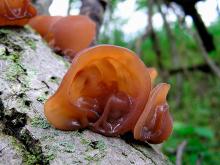
Species Types
Scientific Name
Auricularia auricula (formerly A. auricula-judae)
Description
The wood ear is a reddish brown to grayish black, rubbery, earlike or cup-shaped mushroom. It usually grows in groups on rotting wood.
Media
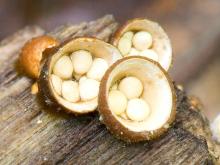
Species Types
Scientific Name
Crucibulum laeve
Description
Splash cups have small brown cups holding tiny “eggs” that are each attached to the “nest” by a cord. They grow in clusters on dead wood, debris, wood chips, and mulch.
Media
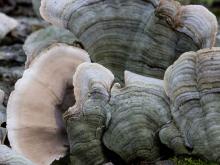
Species Types
Scientific Name
Stereum ostrea
Description
False turkey tail grows in large, layered groups of leathery, parchmentlike brackets with multicolored zones and a smooth underside. Look for it on stumps and logs of deciduous trees, especially oaks.
Media
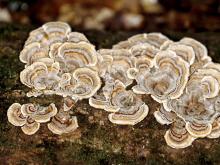
Species Types
Scientific Name
Trametes versicolor
Description
Turkey tail grows in clusters of leathery, thin brackets with multicolored zones above and whitish yellow pores below. Look for it on stumps and logs of deciduous trees.
Media

Species Types
Scientific Name
Trichaptum biforme
Description
The violet toothed polypore is a bracket fungus with tough, hairy caps with violet margins and zones of white, brown, and black; beneath, the whitish violet pores break into teeth. It grows on stumps and logs of deciduous wood.
Media

Species Types
Scientific Name
Lenzites betulina
Description
Multicolor gill polypore is a bracket fungus with a semicircular, tough, hairy, multicolored, zoned cap; beneath, it's white, with leathery, gill-like tubes. It grows on dead deciduous wood.
Media

Species Types
Scientific Name
Amanita spp. (about 600 species, worldwide)
Description
This large group of mushrooms accounts for 90 percent of mushroom-related deaths, so every mushroom hunter should be familiar with amanitas. They contain one of the deadliest poisons found in nature!
Media
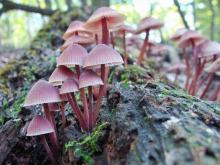
Species Types
Scientific Name
Mycena haematopus
Description
The bleeding mycena is a small mushroom with a bell-shaped, reddish brown cap that bleeds dark red when cut. It usually grows in clusters on decaying wood.
Media

Species Types
Scientific Name
Lycogala epidendrum
Description
Wolf's-milk slime looks like little, round, reddish pink balls that exude a pinkish-gray paste when popped. It grows in groups on dead wood, especially large logs. It's not really a mushroom!
Media

Species Types
Scientific Name
Fuligo septica
Description
In addition to "dog vomit" and "scrambled eggs," this slime mold can also look like the foam at the top of a pint of stout beer, or a yellow or tan sponge. It grows on mulch and other decaying wood.
See Also



Media

Species Types
Scientific Name
Monotropa hypopitys
Description
Pinesap is a plant that puts the "wild" in wildflower! It lacks chlorophyll, so its roots connect to fungi underground and absorb nutrients from the fungi.
Media

Species Types
Scientific Name
Cladophora, Pithophora, and Spirogyra spp., and others
Description
Filamentous green algae forms green, cottony masses that are free-floating or attached to rocks, debris, or other plants.
Media

Species Types
Scientific Name
Monotropa uniflora
Description
Indian pipe lacks chlorophyll, so it is white, not green. Below ground, its roots join with fungi that connect to tree roots. This plant, then, takes nourishment indirectly from the trees.
About Mushrooms in Missouri
Mushrooms are a lot like plants, but they lack chlorophyll and have to take nutrients from other materials. Mushrooms are neither plants nor animals. They are in a different kingdom — the fungi. Fungi include the familiar mushroom-forming species, plus the yeasts, molds, smuts, and rusts.
Always be cautious when eating edible mushrooms. Be absolutely sure of the ID, and only eat a small amount the first time you try it to avoid a reaction..





















